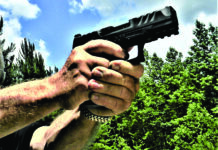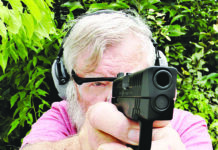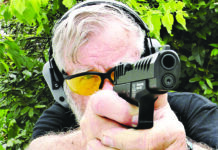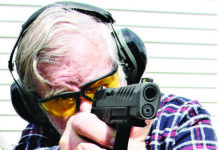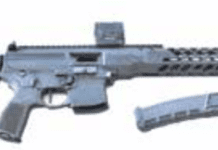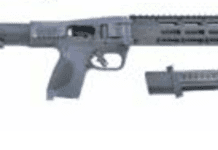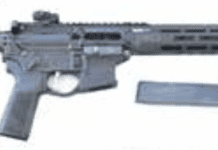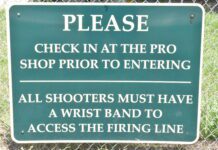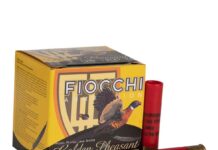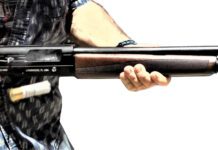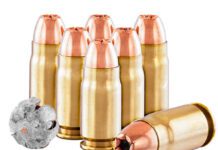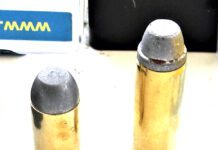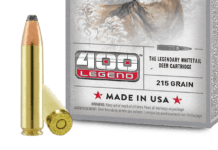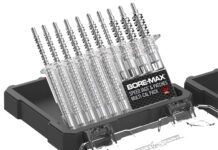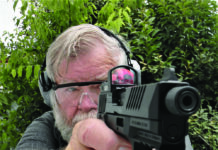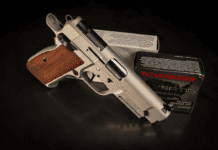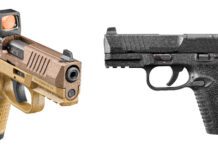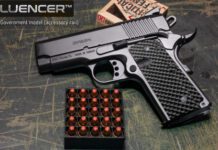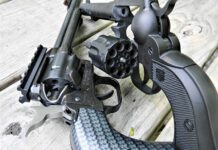New Shotguns at SHOT 2017
At the 2017 SHOT Show in Las Vegas, versatility best explains the new offerings for this year. Manufacturers are building new pursuit-driven shotguns and tweaking current offerings to provide even more niche specialization of their products. It doesn't matter whether you're looking for a duck-blind gun or a behind-the-truck-seat compact scattergun, there is no lack of diversity in the shotgun category this year.
Trump’s Gun Agenda and Gun Tests’ Glossy New Look
Dear Mr. Woodard: First, let me compliment you on the continued publication of your fine magazine! Just read your editorial concerning the presidential election. I don't know how many people understand how clear the correlation between Ms. Clinton's vehement anti-2A views and her loss of what should have been a slam-dunk win. If the numbers are remotely correct, there are 80 million gun owners in America. This number presumes that most of those folks are adults and not felons; therefore, they were potential voters. Another stat says that roughly 1 out of 20 Americans have a concealed-carry permit.
Budget 20-Gauge Shoot Off: H&R, Century, and Mossberg
The shotgun can be an important part of the home-defense firearms collection. The scattergun offers excellent hit probability and provides a formidable option for those concerned with home invasions. The wisdom of such preparedness is reflected in the headlines every day. We live in a dangerous world. The problem is, many of us are on a budget and cannot afford a thousand-dollar tactical shotgun. Others are recoil shy or have a physical impairment that makes firing the mighty 12 gauge difficult. Even some who may be able to handle the 12 well will find the light and fast-handling 20 gauge has appeal.
In this installment, we test three affordable 20-gauge shotguns. The 20 gauge was chosen because, while generating about half the recoil of the 12 gauge, it has a little more than half the payload, which considering the ample power of the shotgun, seems to be a reasonable trade off. Even better for the tests, as it turns out the shotguns were choked Open, Modified and Full, giving us a unique opportunity to compare chokes and how they affect shot spread at home-defense ranges. After weeks of searching, we found three shotguns at or under $300. These included the Century International Arms JW-2000 double-barrel coach gun, a Mossberg 20-gauge pump, and an H&R Pardner single shot. Some may scoff at the idea of even considering the single shot or double barrel for home defense, but we found that while they might not be ribeye, they aren't chopped liver if used properly.
Shotgun Shootout: Self-Loader, Pump, or Dual-Action Design?
When we decided to test three tactical shotguns suitable for home defense, rather than test three pumps or three self-loaders, we tested one of each, and one that could be either. The Benelli Nova Tactical Pump was our first type, followed by a semi-auto Mossberg 930 Tactical and TriStar's TEC-12, the latter of which can operate as a pump or semi-auto. If we were jumping into the sandbox at the moment, we think the Benelli M3 might be our choice, especially after firing the near clone of it, the TEC-12. However, the team thought the Benelli Nova pump had the simplest action to use well, and for us, its performance could not be faulted. The Mossberg 930 Tactical had its advantages as well, among them being it was the most comfortable shotgun to fire and use. We had our preference, as we describe below, but you may decide one of the others is better for you. To make that decision easier, our shooters went over the three guns with an eye toward finding flaws, and before we begin in earnest, we will say we found few problems, and that any of these three would do good duty for home defense.
We have had generally good luck with Benelli's Nova variations over the years. Way back in July 2007, we tested the field-grade Benelli Nova Pump 12 Gauge and gave it an "A-" for its overall performance, the feel and function of the synthetic stock and forearm, and its selection of choke tubes, which was impressive for this bargain-priced firearm. Then in the October 2013 issue, we tested a Benelli Super Nova Tactical No. 29155 12 Gauge. That gun earned an "A-" grade, losing out to a less expensive Stevens 320 that was every bit as good as the Super Nova and hundreds of dollars cheaper. Also, that Tactical Super Nova was the heaviest of those shotguns, which can be good or bad depending on the shooter and the load. But in that test, our shooters particularly liked the feel of the grooved polymer forearm and pistol grip. Downside: The out-of-the-box trigger pull of 8.75 pounds was too hefty for our tastes. Functionally, however, the Super Nova was fine. Those same likes carry over to a Benelli Nova H2O, which features a nickel-plated barrel, that we have not worked into a head-to-head against other corrosion-resistant units. Functionally, it has felt and operated like the other Novas we've tested, but the unit we've been shooting off and on (No. 20090, $669 MSRP) for a couple of years has open rifle sights (blade front and rear notch), which we don't like as well as the Ghost Ring sight on the Nova Tactical, and the price is a big step up from the plain black Benelli. At the time of this test, GanderMountain.com listed the H2O at $650, not including shipping and other charges such as FFL receiving fees. If you need the anti-corrosion features, you may be willing to pay the premium price for it, but for us, because of the price and the sights, we'd have to call the H2O a "B" in terms of value.
2016 Guns & Gear Top Picks
Toward the end of each year, I survey the work R.K. Campbell, Roger Eckstine, Austin Miller, Robert Sadowski, David Tannahill, Tracey Taylor, John Taylor, Rafael Urista, and Ralph Winingham have done in Gun Tests, with an eye toward selecting guns, accessories, and ammunition the magazine's testers have endorsed. From these evaluations I pick the best from a full year's worth of tests and distill recommendations for readers, who often use them as shopping guides. These choices are a mixture of our original tests and other information I've compiled during the year. After we roll high-rated test products into long-term testing, I keep tabs on how those guns do, and if the firearms and accessories continue performing well, then I have confidence including them in this wrap-up.
Correcting The H&R Single Shots Problems
Harrington and Richardson made single-barrel shotguns for more than 100 years, and the basic design didn't change when New England Arms took over. The shotgun action we will use for this chapter is from one of the company's latest model series.
Home-Defense Shotguns: We Compare Three Pump Actions
The shotgun is seen by many as the best choice for personal defense and especially home defense. The most powerful portable shoulder-fired weapon used for self preservation, the 12-gauge shotgun offers a multiple-projectile load that has been proven effective in close-quarters defense. With slug loads, it is even suitable for defense against large, dangerous animals. In rural defense, there are plenty of deadly predators in the country, feral dogs, mountain lions, and other dangerous animals that only an aggressive counterattack will stop. But without proper firearm and load selection, as well as training, the shotgun will be underutilized. More than one citizen has defended himself with the shotgun, and common sense tells us that we should have one in the home.
In this test, the shotguns we chose are among the best in their price range. The choices range from a pedestrian bead-sighted model to a tactical model with an AR-15 type stock. While self-loaders rule the day at 3 Gun competitions and are very reliable, a dirty pump will work when a dirty automatic will not. We have seen self-loaders malfunction during our test programs, and we know the pump-action shotgun is relatively easy to master, as long as you get quality training so you're confident in your skills and sure in your manipulation.
With this in mind, we chose three likely shotguns for home defense. The top end of the budget was $450, but we would prefer to spend less to get a good pump-action gun, if we could. We fired them with practice loads, home defense loads, good loads suitable for pest and predators, and slugs suitable for defense against large animals. We used five different loads for testing these shotguns. We tried to find the most economical offerings in bulk. This included the Fiocchi 12HV75 birdshot ($97 for 250 shotshells from CheaperThanDirt.com) Fiocchi 1-ounce Aero slugs ($8.10/10 from VenturaMunitions.com), Hornady 86240 Critical Defense 00 buckshot loads ($11.08/10 from CheaperThanDirt.com), Hornady's Varmint Express, a load using 24 pellets at 1350 fps ($16/10 from Gandermountain.com), and Winchester 3-inch 12-gauge 00 buckshot loads (No. XB12300VB, $17/15 from CheaperThanDirt.com) This selection covered the likely uses for personal defense, predators, and even large animals. Each shotgun was fired with 50 birdshot shells, 10 of each of the buckshot loads, and 10 Fiocchi slugs, for a total of at least 90 shells per gun. This is punishing work and was not accomplished in a single range session. We fired mainly the light-kicking birdshot to learn how to function the guns quickly and determine their smoothness and ergonomics.
Here are the results.
Waterfowling Shotguns: We Like The Winchester Super X3 Best
Waterfowl sportsmen have greatly changed from the days of market hunters where the daily goal was simply to put huge numbers of birds on the ground in an attempt to satisfy the family dinner needs. Of course, today's waterfowl hunters are strictly limited by migratory bird regulations restricting waterfowl hunting to non-toxic shot with very reduced bag limits on both ducks and geese.
In a way, semiautomatic shotguns designed for waterfowl hunters are like little babies in a beauty pageant. While the parents may think their youngster is the cutest thing on the planet, the pageant judges always apply their own standards and personal preferences in selecting the best in show. This similarity was brought to our attention when a reader asked for a ranking of the best semiautomatic 12-gauge shotguns for bringing down ducks and geese. Without specifying some parameters — such as most used, best handling, affordability, reliability, and a variety of other factors — there can be no single best waterfowl semiautomatic. However, to provide our readers with some options in selecting their best smokepole, we were able to come up with a comparison of four popular, moderately priced semiautomatic waterfowl shotguns. The models included a Browning Maxus, listing for $1520; a Mossberg Model 930 Waterfowl, listing for $797; a Beretta Model A300 Outlander, listing for $845; and a Winchester Super X3, with a suggested retail of $1200. Each was found to feature both favorable and unfavorable elements that varied in importance with each member of our test team. In the end, the patterning-board performance and pocketbook impact proved to be the main separating factors in our ranking.
Our selection of ammunition to test the functioning ability, patterning performance and felt recoil of the semiautomatics included both clay-target loads and a typical waterfowl load. For clays, we used the recently introduced Browning BPT 2.75-inch, 3 dram equivalent loads packing 1 1/8 ounce of No. 7.5 shot with an average muzzle velocity of 1200 fps; and B&P Competition One 2.75-inch, 28-gram loads featuring 1 ounce of No. 7.5 shot with an average muzzle velocity of 1160 fps. To test the shotguns with duck loads, we selected Federal Premium Tungsten 3-inch, 3 dram equivalent No. 2 shot loads with an average muzzle velocity of 1,400 feet per second. Here are our findings:
28-Gauge Showdown: Benelli, Franchi and Weatherby Face Off
In our May 2015 evaluation of 28-gauge shotguns, we focused on a pair of gas-operated semi-automatics and found both the Legacy Sports Pointer and the Beretta Excel shotgun had a lot to offer. Our intention was to follow up with two or three more gas-op 28-gauge autoloaders, but we ran into a problem. The actual number of 28-gauge shotguns of any description currently being produced is relatively small. So for anyone looking to buy a 28-gauge shotgun, they will need to widen their search and consider not just the gas-operated semi-automatics, but also recoil-operated semi-autos and over-under shotguns as well. That is just what we did when setting up shotguns for this test.
Our representative gas-operated shotgun was the Turkish-made $899 Weatherby SA-08 Deluxe. The Weatherby was actually scheduled for our 2015 evaluation, but a manufacturer's recall prevented us from acquiring one. The Weatherby in this year's test was an updated post-recall shotgun.
Next, Benelli is famous for its recoil-operated semi-automatic shotguns, but the company has adopted a term they feel is a more-accurate description — inertia driven, which may indeed offer a more suitable description of how it operates. That is the action in the $2039 Benelli Legacy tested here, one of the more refined semi-automatic shotguns available today.
To round out the crew, we chose the $1,699 Franchi Instinct L, an over/under shotgun that is still light, despite having two barrels. Both the Benelli and the Franchi were made in Italy, and, not surprisingly, they are both owned by Beretta.
Our testing procedure began with patterning each shotgun from a distance of 25 yards with a Modified choke installed. Since the Franchi had two barrels and order of fire was interchangeable upon command, we patterned each barrel as though it were two different shotguns, changing to the Modified choke for each pattern. Three shots were fired on the target to give us a true reading of pattern spread and point of impact.
All three guns accepted 2-inch shells, and our three test loads were each rated at 1200 fps carrying ounce shot charges. The Estate Super Sport Competition Target load held No. 7 shot. Our Fiocchi 28GT8 load delivered No. 8s, and the Winchester ammunition was loaded with No. 9s.
The second phase of our tests was more fun than patterning, beginning at the self-pull stations at American Shooting Centers in Houston. From there we moved to ASC's skeet ranges. Here's what we learned about the shotguns on the range.
Semi-Auto 12 Gauges from Benelli, Beretta, and Mossberg
While pump-action shotguns have long been the traditional standard for tactical firearms, for self defense and in law enforcement or combat situations, there are several semiautomatics on the market providing another option to the shooting public. Touching off a round with every pull of the trigger in a semiautomatic, rather than having to shuck a shell into the chamber each time with a pump action, just fits the tastes of a lot of shooters on the range and when there is a need for speed in self-defense situations. In most cases, semiautomatics are slightly faster and easier to hold on target than their pump-action cousins. At the request of a reader interested in semiautomatic tacticals, we were able to obtain a trio of these special firearms to test and review.
The models included a Benelli Model M4, listing for $1,999; a Beretta Model 1301, listing for $1,075; and a Mossberg Model 930 SPX with a suggested retail of $836. Other than the pistol grip featured on the Benelli, the three shotguns were remarkably similar in appearance, with identical Ghost Ring rear sights. The difference in handling ability and speed proved to be the major factor separating the best from the rest.
In the days of old, being quicker on the draw often meant the difference between winning and losing a gun battle — with certain caveats. Accuracy and reliable functioning of the firearm were also important in situations where a shooter's life might depend upon a second, third, fourth, or fifth shot being fired quickly and effectively.
In today's world, self-defense scenarios in which multiple shots are required to eliminate a threat are, thankfully, rare for most law-abiding citizens. However, there can be cases where personal needs or personal desires can lead a shooter to look at the possibility of putting a semiautomatic shotgun into play.
Such is the case with aGun Testsreader who contacted us with a request for a review of three semiautomatic tactical shotguns readily available to today's shooting public. He specifically requested evaluations of aBenelli Model M4, listing for $1,999; aBeretta Model 1301, listing for $1,075; and aMossberg Model 930 SPXwith a suggested retail of $836. While the price range of the three semiautomatics is quite a stretch, the appearance, handling ability, and speed of the trio are very similar.
Just like in the world of clay target shooting, a key factor with semiautomatics is their ability to reliably function. Some shooters have been heard to refer to semiautomatics as "jam-o-matics" because of failures to cycle loads. On the clay target range, a jam at the wrong time can mean the loss of a target; but in a self-defense situation, a jam can leave a shooter holding a club in a gunfight.
Being certain a firearm will function every time is a very important factor in a shooter's decision to select the right firearm for the right use at the right time. To test the functioning ability, speed of fire, and speed of loading — in addition to checking the accuracy of our three semiautomatics — we selected a trio of loads that could feasibly be put into play as part of potential self-defense or possible close-combat situations. The ammunition included Remington ShurShot Heavy Dove 2.75-inch, 3.25-dram-equivalent loads packing 11⁄8 ounce of No. 6 shot with an average muzzle velocity of 1255 fps; Remington Managed-Recoil No. 00 Buckshot 2.75-inch loads moving eight pellets at an average muzzle velocity of 1200 fps; and Winchester PDX1 Defender 2.75-inch loads pushing a 1-ounce segmented rifled slug at an average muzzle velocity of 1600 fps.
We usedBirchwood Casey Eze-Score BC-27 Green Targetsfor all of our testing, with slug tests at targets set 30 yards downrange (about the maximum for a self-defense situation); and set at 20 yards downrange for the buckshot and No. 6 shot loads. Here are our findings.
New Long Guns Coming for 2016
At the 2016 SHOT Show in Las Vegas, Gun Tests staffers ran across many dozens of new products that we're working to include in future tests. Following are some of the rifles, rifle ammunition, shotguns, and long-gun accessories we found interesting. If there's something in particular you want us to test, please drop me a note at GunTestsEditor@icloud.com.
Barnes Bullets has added two new loads to the VOR-TX line of premium ammunition. The first is a 130-grain Tipped Triple Shock load for the 308 Winchester. It is rated at 3,170 fps, and it takes the 308 Winchester into a new realm of velocity. SRP: $45.69 for a 20-round box. The second load is an 190-grain LRX bullet for the 300 Winchester Magnum. This bullet's ogive and cannelure design gives it a high B.C., and the nose cavity engineering ensures it expands reliably at lower velocities. It is rated at 2,860 fps.
The Woodsman rifle is new from Bergara. This bolt-action hunting rifle weighs 7.4 pounds in long action and 7.1 pounds in short action. It has a hinged floor plate and comes with a 22- or 24-inch, No. 3 contour barrel. The stock is American walnut, and available chamberings include 6.5 Creedmoor, 7mm Rem. Mag., 308 Win., 30/06, and 300 Win. Mag.
Browning's biggest shotgun news is that the Sweet Sixteen is back. Like its most revered predecessor, the new A5 Sweet Sixteen is built on a smaller, lighter receiver for reduced weight and a sleek feel. The A5 uses kinetic energy to power the recoil-operated Kinematic Drive System for reliable function with any load and under the full extremes of weather, temperature, moisture, or grime. The A5 16-gauge receiver is constructed of aluminum with a black anodized bi-tone finish. The stock—shim-adjustable for length of pull, cast, and drop—and forearm are gloss finish walnut with a close-radius pistol grip and sharp 18 lines-per-inch checkering. The gun uses Browning's Invector DS choke system; three chokes will be supplied with 2 -inch chambered barrels in 26- or 28-inch lengths. Weight: 5 pounds 12 ounces.
Benelli’s Over/Under Shotgun Cant Beat Browning
When a firearm manufacturer with a reputation of producing high-quality, durable semiautomatics ventures into the under/over market, a lot of shooters will take notice. Such is the case with the new Benelli Model 828U that made a big splash at the January 2015 SHOT Show. The company's first attempt at offering shooters a stack-barrel, rather than a semiautomatic, prompted our readers to call for our shotgun test team to put together a match-up of the Benelli 828U with a comparable model made by another firearm manufacturer.
The recent release of the Browning Citori Model 725 Field seemed to be perfect timing for the head-to-head competition. We pitted the Benelli 828U, retailing for $2,500, against the Browning 725, retailing for $2,470, both at the clay-target range and on the patterning board to see if the new smokepole performed as advertised against a proven product sitting in the rack beside it.
While pump-action and semiautomatic shotguns are the overwhelming favorite field guns throughout the shooting community, over/unders are the kings of clay-target shooters. Because of reasons like their better handling ability, two-choke option, and the fact that most clay target shooting is limited to taking only two shots at a time, stackbarrels reign over clays. That truism may be one of the reasons why the release of a first-ever over/under produced by veteran semiautomatic manufacturer Benelli was greeted with such fanfare. Shooters of all ages seem to be fascinated with new toys from names they know — particularly if the latest and greatest will help break a few more clays or help fill up the game bag a little quicker.
When the new Benelli Model 828U was introduced, devoted fans of Benelli semiautomatics rushed to get more information. At the same time, and with a lot less fanfare, over/under manufacturer Browning Arms introduced a field version of its popular Citori Model 725, which is the latest in the Citori Model 25 line that dates back to the 1970s. A tweak here and a tweak there have been billed as making the new Model 725 Field a top pick for clays and birds.
We should note that the version of the Benelli made available to us was a 26-inch-barrel anodized-aluminum receiver model, while the Browning provided featured 28-inch barrels and a silver nitrite receiver. We made allowances in our testing for the slightly better handling characteristics that are generally attributed to longer barrels and a heavier gun, ensuring these factors did not influence our evaluation.
The ammunition we selected for our testing on the target range and at the patterning board was Winchester AA Extra-Light Target 2.75-inch loads packing 1 ounce of No. 71⁄2 shot with an average muzzle velocity of 1,180 fps. Also, we fired 2.75-inch Nobel Low Recoil Target loads with 7⁄8 ounce of No. 8 shot and an average muzzle velocity of 1,200 fps. Here are our findings.


